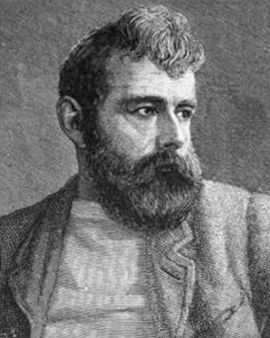


Willian Lionel Wyllie - a name that is connected like no other with the realistic painting of the former Great Seal Great Power Great Britain. His pictures of the great naval battles of Trafalgar, the Battle of the Falkland Islands or "Track of Lusitania" are known to all British people since childhood. Even non-British art lovers with a preference for maritime and military motifs are familiar with William Lionel Wyllie's work.
Raised in France as the son of the painter William Morrison Wyllie, his interest in painting was encouraged from childhood on. He later attended the independent Heatherley School of Fine Art in London, as did his Hallbrother - the Victorian painter of idyllic motifs Lionel Percy Smythe. There he refined his technique and expressiveness to such an extent that he was accepted at the Royal Academy Schools at the age of 15. At 18 he was awarded the Turner Gold Medal for his oil painting "Dawn after a Storm". A honour that should become a door opener for him in his career. With this painting, a medium-sized sailing ship sailing towards the coast, a wider public became aware of him. This was the beginning of his graphic work on maritime topics for the magazine "The Graphic". This high-circulation weekly magazine influenced the art world of Europe far beyond the borders of the Commonwealth. The pictorial motifs created by W L Wyllie - as he called himself from the beginning of his career - thus influenced the idea of the lives of seafarers around the world. Colourful sunsets, impressive sailing ships and later the warships of the early 20th century inspired the imagination. But you didn't have to be a subscriber of The Graphic to see the pictures. During this period, around the 1900s, it became possible for the wider society in England to go to public museums and view the works exhibited there. And if you were employed at the British Stock Exchange, the London Exchange, you could see one of W L Wylie's fantastic murals there every day.
With his economic success W. L. Wyllie was able to create an extremely generous family life. His wife Marion bore him nine children, five of whom reached adulthood. The First World War, however, brought further blows of fate to the Wyllie family, the two sons Bill and Robert fell in the war. Through the time of mourning, painting and his routine daily routine could help him. He was a physically very fit man, after all he stood most of his work effortlessly on easels until he was 79 years old. His grave in the cemetery of Porchester Castle is a place of silent remembrance not only for art lovers but also for sailors.

Willian Lionel Wyllie - a name that is connected like no other with the realistic painting of the former Great Seal Great Power Great Britain. His pictures of the great naval battles of Trafalgar, the Battle of the Falkland Islands or "Track of Lusitania" are known to all British people since childhood. Even non-British art lovers with a preference for maritime and military motifs are familiar with William Lionel Wyllie's work.
Raised in France as the son of the painter William Morrison Wyllie, his interest in painting was encouraged from childhood on. He later attended the independent Heatherley School of Fine Art in London, as did his Hallbrother - the Victorian painter of idyllic motifs Lionel Percy Smythe. There he refined his technique and expressiveness to such an extent that he was accepted at the Royal Academy Schools at the age of 15. At 18 he was awarded the Turner Gold Medal for his oil painting "Dawn after a Storm". A honour that should become a door opener for him in his career. With this painting, a medium-sized sailing ship sailing towards the coast, a wider public became aware of him. This was the beginning of his graphic work on maritime topics for the magazine "The Graphic". This high-circulation weekly magazine influenced the art world of Europe far beyond the borders of the Commonwealth. The pictorial motifs created by W L Wyllie - as he called himself from the beginning of his career - thus influenced the idea of the lives of seafarers around the world. Colourful sunsets, impressive sailing ships and later the warships of the early 20th century inspired the imagination. But you didn't have to be a subscriber of The Graphic to see the pictures. During this period, around the 1900s, it became possible for the wider society in England to go to public museums and view the works exhibited there. And if you were employed at the British Stock Exchange, the London Exchange, you could see one of W L Wylie's fantastic murals there every day.
With his economic success W. L. Wyllie was able to create an extremely generous family life. His wife Marion bore him nine children, five of whom reached adulthood. The First World War, however, brought further blows of fate to the Wyllie family, the two sons Bill and Robert fell in the war. Through the time of mourning, painting and his routine daily routine could help him. He was a physically very fit man, after all he stood most of his work effortlessly on easels until he was 79 years old. His grave in the cemetery of Porchester Castle is a place of silent remembrance not only for art lovers but also for sailors.
Page 1 / 4






